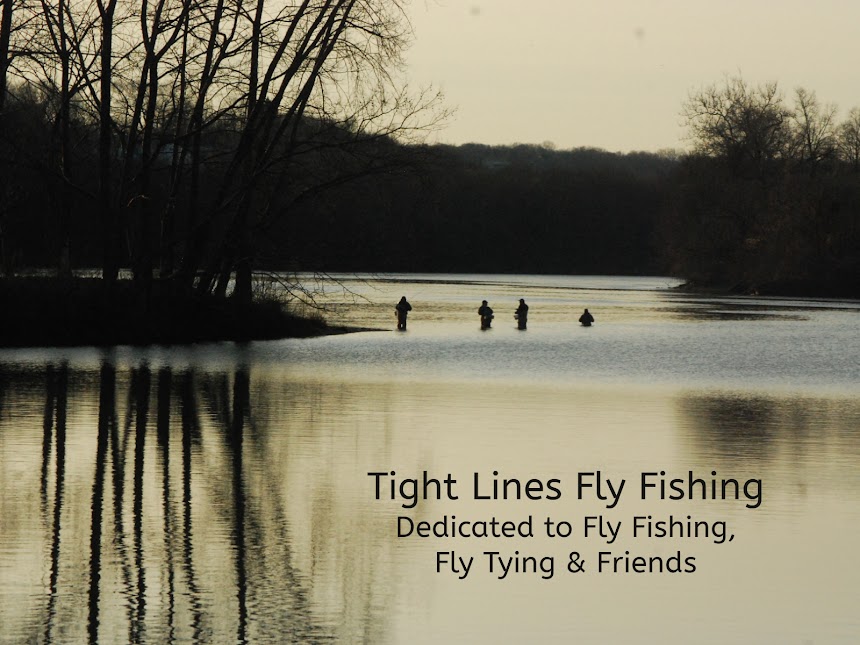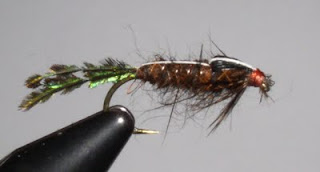“Skull Head” Deceiver
Hook: Tiemco 600SP size #2 to #4/0, or salt water hook of preference.
Thread: White flymaster+ or color matching upper wing color.
Tail: 6 White saddle hackle tied in deceiver style.
Body: Pearl body braid (wrapped over the hook shank after the tail is applied).
Lower wing: White buck tail -- two bunches of buck tail are tied in on each side, slightly angled down toward the hook point, extending almost to the tips of your saddle hackle. Topped with pearlescent Flash-a-bou, or Polar Flash, or flash material of choice.
Upper Wing: Chartreuse, or olive, or pink, or color of choice buck tail. Topped with pearlescent Flash-a-bou, or Polar Flash, or flash material of choice, then topped with peacock or green flash-a-bou.
Fish Skull: To match hook size.
I caught a lot of fish using this pattern this past spring. Similar to a clouser minnow, the weighted “head” of the fly gives it a jigging action. What’s great about the “fish heads” is that they can be applied to the hook so that the fly fishes hook point down or inverted like a clouser.
The key to tying this fly is to make sure you leave enough room to apply the “fish skull” at the end of the tying process. Begin by advancing your thread from the hook eye to the bend of the hook. Next, tie in your 6 saddle hackle on top of the hook shank “deceiver” style. The feathers should extend anywhere from 1 ½ to 2 ½ times the length of the hook shank. Next, tie in your pearl body braid near the bend of the hook. Palmer it forward and tie off leaving approximately ¼ of the hook shank to the eye. I then coat it with ‘tough as nails’ for added durability. You can also take time to test that your “fish skull” will fit properly over the eye of the hook. I usually do this a couple times during the tying process. Next tie in two bunches of white buck tail on each side of the hook shank. They should be a little shorter than the tail, and slightly angled down. Top the lower wing/tail with pearlescent Flash-a-bou or Polar Flash. It should extend to the tip of the tail. Next, tie in your upper wing (chartreuse, olive, or color of choice). It should also extend to the tip of the tail. Top with more pearlescent Flash-a-bou. Finally top it with peacock or dark green Flash-a-bou. You’re now ready to apply your “fish skull”. Tie off your thread. Before applying the “fish skull” to the hook shank, coat the contact area with head cement or adhesive of choice. Follow the “fish skull” directions. Depending upon how you affix it to the hook shank, the fly will either fish with the hook point down, as any traditional fly would, or you can apply it to the hook shank so your fly will fish inverted just as a traditional clouser would. If you tied the fly properly, the eye of the hook will extend just beyond the fish skull. Re-apply and make a number of wraps with your thread just before the hook eye, then tie it off again. Apply head cement. This is to further ensure that the “fish skull” will stay permanently affixed to the hook. (I’ve never had one loosen up on me yet, but this is the manufacturer’s recommended tying method.) I don’t know if this fly out fishes clousers, but they sure work. Only drawback is they aren’t cheap.
This fly can also be viewed at the Housatonic Fly Fishermen's Associaton website at http://www.hffa.net/ . If you have any questions about this fly or would like to submit a pattern of the month email me at pdinice@frontier.com .













